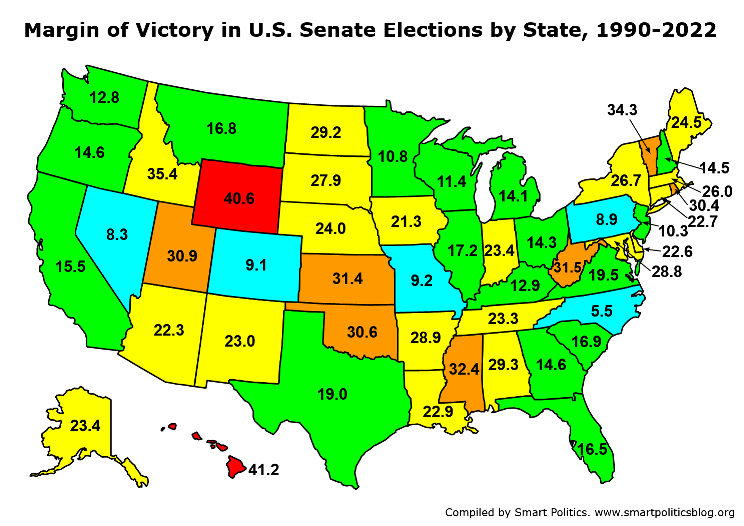The Most Competitive States for US Senate Elections Since 1990
Three of the top five states host contests in 2024

Since 1990, the average victory margin in U.S. Senate contests has been less than 10 points in just five states: North Carolina (5.5 points), Nevada (8.3 points), Pennsylvania (8.9 points), Colorado (9.1 points), and Missouri (9.2 points).
Democratic incumbents Jacky Rosen of Nevada and Bob Casey of Pennsylvania are among the handful of most vulnerable incumbents on the ballot this autumn, while Missouri Republican Josh Hawley’s seat is viewed as safe by all D.C. prognosticators, despite the lawmaker winning by just 5.8 points in 2018.
But when it comes to marquee matchups for the nation’s upper legislative chamber, no state can touch North Carolina.
Eleven of the Tar Heel State’s 12 elections for the office since 1990 (and 16 of 17 since 1978) have been single-digit affairs.
Only Colorado (eight of 12 elections), Georgia (nine of 14), Nevada (seven of 12), Pennsylvania (seven of 12), Missouri (seven of 12), Minnesota (seven of 12), and New Hampshire (seven of 12) have had more than a half-dozen single-digit victory margins during the last 32 years.
Nevada has also hosted the closest U.S. Senate race in the nation in two of the 16 cycles since 1990 including 2022’s 0.8-point victory by incumbent Catherine Cortez Masto over former GOP Attorney General Adam Laxalt. In 1998, Senator Harry Reid won a third term by just 0.1 points over Republican U.S. Representative John Ensign.
Three other states share that mantle: Florida (2004, 2018), Minnesota (1990, 2008), and Virginia (2006, 2014).
Of the remaining handful of states expected to have showdowns at the ballot box in 2024, only one – Wisconsin – cracks the Top 10 for most competitive elections over the last 30+ years (#8, 11.4 points average MoV).
Michigan ranks #11 (14.1 points), Ohio #12 (14.3 points), Montana #18 (16.8 points), and Arizona #24 (22.3 points).
Of course, every now and again notoriously non-competitive states can produce a very close race. Sometimes this occurs due to the quality of the candidates nominated by the two major parties (e.g. Alabama’s 2017 special election between Doug Jones and Roy Moore decided by 1.6 points) and sometimes because of major partisan shifts in the electorate (e.g. West Virginia’s 2018 election between Senator Joe Manchin and Attorney General Patrick Morrissey decided by 3.3 points).
Even still, seven states have yet to hold a U.S. Senate election decided by single digits since 1990, although each had at least one race decided by less than 15 points:
- Delaware (2000, 11.8 points): Democratic Governor Tom Carper unseated five-term U.S. Senator William Roth
- Maryland (2006, 10.0 points): Democratic U.S. Representative Ben Cardin defeated Lieutenant Governor Michael Steele
- Oklahoma (2004, 11.5 points): Former GOP U.S. Representative Tom Coburn beat sitting U.S. Representative Brad Carson
- Utah (2022, 10.4 points): Republican Senator Mike Lee won a third term with independent Evan McMullin making last cycle’s race the closest in the state since 1974
- Kansas (1996, 10.58 points): GOP U.S. Representative Sam Brownback beat investment broker Jill Docking (a slightly more competitive matchup than Senator Pat Roberts’ 10.62-point victory over independent Greg Orman in 2014).
- Idaho (1992, 13.1 points): Boise Mayor Dirk Kempthorne defeated Democratic congressman Richard Stallings
- Wyoming (1996, 11.9 points): GOP State Senator Mike Enzi beat Secretary of State Kathy Karpan
Delaware, Maryland, Utah and Wyoming will have U.S. Senate races this November. All but Wyoming are open-seat races but none are expected to have competitive general elections.
Follow Smart Politics on X/Twitter.


We got another year on our hands AGAIN. This November please everybody you can out to VOTE like your lives depend on it.
In NJ if Bob Menendez loses the primary, it’ll be the 1st time an incumbent lost since 2012 and in WV, Joe Manchin retiring means this will be the 1st open democratic seat gained by republicans since 2014.
An ‘incumbent’ senator more recently lost his retention bid – in 2017, when appointed Senator Luther Strange lost to Roy Moore (who in turn lost, as mentioned in text).
My surmise is that all statewide contests in the Tar Heel State – the 10 ‘Council of State’ posts + president – will in all likelihood end up with single-digit margins, given the extremely INELASTIC character (i.e. very few persuadable voters) of the electorate of the state.
In some elections – e.g. AR, GA, and MS in 1990 – the MoV were literally 100% since they were UNCONTESTED elections. Have such elections been included in the aforementioned tally?
Indeed – I always include uncontested elections in my MoV analyses. My rationale is the inability of a party to even field a nominee is telling of the partisan disparity in a given state, and needs to be captured in the data instead of ignored.
CA: I shall go on record predicting that one of the 2 spots for the initial round will be clinched by Representative Adam Bennett Schiff (D). Should the other spot be claimed by another Democrat, rather than first-time political candidate Steven Patrick Garvey (R), the ‘MoV’ – in terms of the D v R disparity – will be 100%, which also had been the case in 2018 and 2016.
With 2-term incumbent “Tom” Tillis calling it a congressional career, this seat will become an open contest (yet again) – and at least a likely hyper-competitive general election (Contested primaries? A certain FL resident will likely pre-empt the R field should she choose to set aside her ‘singing career’ and make a bid, rather than just tease at a candidacy). Of course, it would have been fiercely competitive even with Tillis as the R nominee, something that would not have been a foregone conclusion.
With his extremely narrow re-election win in 2020, Tillis managed to become the first incumbent from this seat to attain re-election since 1996. Were it not for the Biden/Harris loss at the presidential level statewide and his gaffe involving ‘barbecue and grill’ a Senator Cunningham (Democrat) would be defending this seat now instead.
Another noteworthy fact is that this seat, arguably starting with the 1978 cycle, consistently has ended up with the highest price tags for each cycle. Indeed, for the 2002, 2008, 2014, and 2020 elections, total spending (candidates, parties, allied groups) for them has been among the three highest for each cycle (courtesy: Sabato’s Crystal Ball).